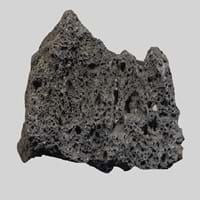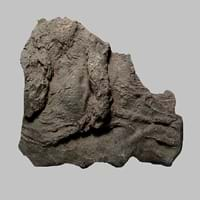Definition
Scoria is a dark-colored extrusive igneous rock with abundant round bubble-like cavities
During the impact melted material forming a breccia containing glass and crystal or lithic fragments together form Suevite rock.
Origin
Unknown
Canada, Germany
Discoverer
Unknown
Unknown
Etymology
From late Middle English (denoting slag from molten metal), from Greek skōria refuse, from skōr dung
No etymologies found
Class
Igneous Rocks
Metamorphic Rocks
Sub-Class
Durable Rock, Medium Hardness Rock
Durable Rock, Medium Hardness Rock
Group
Volcanic
Not Applicable
Other Categories
Fine Grained Rock, Opaque Rock
Coarse Grained Rock, Opaque Rock
Color
Black, Brown, Dark Grey to Black, Red
Black, Brown, Colourless, Green, Grey, Pink
Durability
Durable
Durable
Scratch Resistant
Yes
Yes
Appearance
Glassy and Vesicular
Banded
Interior Uses
Decorative Aggregates, Interior Decoration
Decorative Aggregates, Homes, Interior Decoration
Exterior Uses
Garden Decoration, Paving Stone
As Building Stone, As Facing Stone, Garden Decoration, Office Buildings
Other Architectural Uses
Curbing
Curbing
Construction Industry
Cement Manufacture, Construction Aggregate, for Road Aggregate, In landscaping and drainage works
As Dimension Stone, Cement Manufacture, for Road Aggregate, Making natural cement, Manufacture of Magnesium and Dolomite Refractories
Medical Industry
Not Yet Used
Not Applicable
Antiquity Uses
Artifacts, Monuments, Sculpture
Artifacts, Monuments, Sculpture
Commercial Uses
As a traction material on snow-covered roads, Creating Artwork, High-temperature insulation, In gas barbecue grills
As a Feed Additive for Livestock, Gemstone, Metallurgical Flux, Source of Magnesia (MgO)
Types
Not Available
Phyllosilicates, Calcite
Features
Available in Lots of Colors and Patterns, Generally rough to touch, Surfaces are often shiny
Host Rock for Lead
Archaeological Significance
Famous Monuments
Data Not Available
Data Not Available
Famous Sculptures
Data Not Available
Data Not Available
Formation
Scoria forms when magma containing huge amount of dissolved gas flows from a volcano during an eruption.
Suevite is a metamorphic rock consisting partly of melted material, typically forming a breccia containing glass and crystal or lithic fragments, formed during an impact event.
Mineral Content
Apatite, Biotite, Calcite, Feldspar, Hematite, Hornblade, Ilmenite, Magnetite, Olivine, Pyroxene, Quartz, Silica
Coesite, Quartz, Stishovite
Compound Content
Ca, NaCl
CaO, Carbon Dioxide, MgO
Types of Metamorphism
Burial Metamorphism, Cataclastic Metamorphism, Contact Metamorphism
Burial Metamorphism, Cataclastic Metamorphism, Contact Metamorphism, Hydrothermal Metamorphism, Impact Metamorphism, Regional Metamorphism
Types of Weathering
Biological Weathering, Chemical Weathering, Mechanical Weathering
Not Applicable
Types of Erosion
Chemical Erosion, Coastal Erosion, Glacier Erosion
Not Applicable
Grain Size
Fine Grained
Coarse Grained
Fracture
Conchoidal
Uneven
Streak
White
Light to dark brown
Porosity
Highly Porous
Less Porous
Luster
Subvitreous to Dull
Earthy
Cleavage
Perfect
Irregular
Toughness
2.1
Not Available
Specific Gravity
Not Available
2.86
Transparency
Opaque
Opaque
Density
Not Available
2.8-2.9 g/cm3
Specific Heat Capacity
Not Available
Resistance
Heat Resistant, Impact Resistant, Pressure Resistant, Wear Resistant
Heat Resistant
Deposits in Eastern Continents
Asia
Afghanistan, Indonesia, Japan, Russia
Not Yet Found
Africa
Ethiopia, Kenya, Tanzania
Not Yet Found
Europe
Greece, Hungary, Iceland, Italy, Turkey
England, France, Germany, Great Britain, Netherlands, Sweden, Switzerland, United Kingdom
Others
Not Yet Found
Not Yet Found
Deposits in Western Continents
North America
Bahamas, Barbados, Canada, Costa Rica, Cuba, Jamaica, Mexico, USA
Not Yet Found
South America
Argentina, Chile, Ecuador, Peru
Not Yet Found
Deposits in Oceania Continent
Australia
New Zealand, Western Australia
Not Yet Found
All about Scoria and Suevite Properties
Know all about Scoria and Suevite properties here. All properties of rocks are important as they define the type of rock and its application. Scoria belongs to Igneous Rocks while Suevite belongs to Metamorphic Rocks.Texture of Scoria is Vesicular whereas that of Suevite is Earthy. Scoria appears Glassy and Vesicular and Suevite appears Banded. The luster of Scoria is subvitreous to dull while that of Suevite is earthy. Scoria is available in black, brown, dark grey to black, red colors whereas Suevite is available in black, brown, colourless, green, grey, pink colors. The commercial uses of Scoria are as a traction material on snow-covered roads, creating artwork, high-temperature insulation, in gas barbecue grills and that of Suevite are as a feed additive for livestock, gemstone, metallurgical flux, source of magnesia (mgo).










